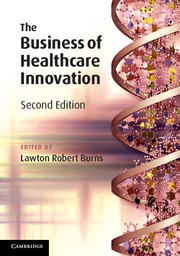Book contents
- Frontmatter
- Contents
- List of Figures
- List of Contributors
- Abbreviations
- 1 The business of healthcare innovation in the Wharton School curriculum
- 2 The pharmaceutical sector
- 3 Pharmaceutical strategy and the evolving role of merger and acquisition
- 4 The biotechnology sector
- 5 Biotechnology business and revenue models
- 6 The medical device sector
- 7 The healthcare information technology sector
- 8 Healthcare innovation across sectors
- Index
- References
6 - The medical device sector
Published online by Cambridge University Press: 05 November 2012
- Frontmatter
- Contents
- List of Figures
- List of Contributors
- Abbreviations
- 1 The business of healthcare innovation in the Wharton School curriculum
- 2 The pharmaceutical sector
- 3 Pharmaceutical strategy and the evolving role of merger and acquisition
- 4 The biotechnology sector
- 5 Biotechnology business and revenue models
- 6 The medical device sector
- 7 The healthcare information technology sector
- 8 Healthcare innovation across sectors
- Index
- References
Summary
Introduction
The medical device sector, an attractive and profitable business, has grown and matured to become a large and established part of the healthcare industry. The broad set of products encompassed by this category span all physician specialties, touch every conceivable anatomy, and are applied to nearly every medical procedure. They range from the simplest surgical staples and sutures to complex electronic implantable devices that essentially perform the practice of an electrophysiologist, monitoring heart function and delivering intelligent electrical therapy. This sector experienced extraordinary growth during the last several decades as technological developments provided medical practitioners with life-saving and life-improving tools, implants and equipment that have changed the very practice of medicine. It was the golden age of medical products. Companies were rewarded mightily for products that unleash value within the clinic by improving outcomes and saving precious time. These products conveyed benefits that were “built in” at the factory and later realized in the clinical setting during medical–surgical procedures that were heavily labor and resource intensive. These benefits were realized by millions of patients worldwide who experienced better outcomes in an acute setting and, in the case of implanted products, enjoyed those benefits throughout their lives.
Medical devices might have been considered a cottage industry as recently as a few decades ago, but after experiencing consistent growth at mid- to high single-digit rates the sector has reached $235 billion in worldwide revenues in 2009 (see Figure 6.1). This total is divided between medical devices, accounting for approximately $146 billion in revenues, and commodity supplies, at $89 billion.
- Type
- Chapter
- Information
- The Business of Healthcare Innovation , pp. 376 - 450Publisher: Cambridge University PressPrint publication year: 2012
References
- 2
- Cited by



